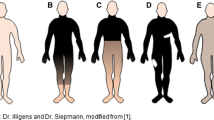Abstract
Purpose
Profound sweating can occur with reflex-syncope and with emotional distress, but little is known about the similarities and differences between these sweat responses when they occur during orthostatic challenge. We sought to characterize and compare the sweat patterns related to tilt-induced syncope, presyncope, anxiety, and normal tilt testing.
Methods
In a prospective observational study, quantitative sweat rate was measured from the abdomen, forearm, ankle, and thigh during head-upright tilt. Sweat characteristics were compared across tilt diagnoses of syncope, presyncope, anxiety, and normal testing. When anxiety and syncope/presyncope occurred during the same study (separated by ≥6 min), both were diagnosed.
Results
Our cohort comprised150 patients (15.1 ± 2.3 years; 82.9 % female) with 156 diagnoses: 76 with reflex-syncope, 31 with presyncope, 23 with anxiety, and 26 with normal results. All syncope/presyncope patients and 20 (87 %) of the anxiety patients had corresponding sweat responses. Minimal or negligible sweating occurred among patients with normal tests. Neither basal sweat (19.4 ± 4.7 versus 18.3 ± 3.7 versus 18.5 ± 3.7 nL/min/cm2) nor peak sweat (171 ± 47.4 versus 149.4 ± 64.4 versus 154.4 ± 59.2 nL/min/cm2) differed between patients with syncope, presyncope, or anxiety, p = .32 and p = .12, respectively. However, the qualitative sweat patterns related to syncope/presyncope (diffuse, smoothly contoured, symmetrical, single peaks) differed considerably from the sweat patterns related to anxiety (heterogeneous, asymmetrical, roughly contoured single-peak, multi-peak, or progressive sweat changes).
Conclusions
The sweat patterns related to syncope/presyncope are distinguishable from the sweat patterns related to anxiety. Recognition of the different sweat patterns can inform how signs and symptoms are interpreted during clinical orthostatic challenge.


Similar content being viewed by others
References
Ganzeboom KS, Mairuhu G, Reitsma JB, Linzer M, Wieling W, van Dijk N (2006) Lifetime cumulative incidence of syncope in the general population: a study of 549 Dutch subjects aged 35–60 years. J Cardiovasc Electrophysiol 17:1172–1176
Ganzeboom KS, Colman N, Reitsma JB, Shen WK, Wieling W (2003) Prevalence and triggers of syncope in medical students. Am J Cardiol 91:1006–1008
Serletis A, Rose S, Sheldon AG, Sheldon RS (2006) Vasovagal syncope in medical students and their first-degree relatives. Eur Heart J 27:1965–1970
Fazelifar AF, Basiri HA, Tolooie A et al (2008) Can prodromal symptoms predict recurrence of vasovagal syncope? Cardiol J 15:446–450
Wieling W, Thijs RD, Van Dijk N, Wilde AA, Benditt DG, van Dijk JG (2009) Symptoms and signs of syncope: a review of the link between physiology and clinical clues. Brain 132:2630–2642
Sheldon R, Rose S, Connolly S, Ritchie D, Koshman ML, Frenneaux M (2006) Diagnostic criteria for vasovagal syncope based on a quantitative history. Eur Heart J 27:344–350
Struhal W, Mismas A, Kirchmayr M et al (2014) Onset of sweating depends on the type of reflex syncope. Auton Neurosci 184:73–76
Edwards MR, Benoit J, Schondorf R (2004) Electrodermal activity in patients with neurally mediated syncope. Clin Auton Res 14:228–232
Graham LA, Kenny RA (2001) Clinical characteristics of patients with vasovagal reactions presenting as unexplained syncope. Europace 3:141–146
Machado-Moreira CA, Taylor NA (2012) Psychological sweating from glabrous and nonglabrous skin surfaces under thermoneutral conditions. Psychophysiology 49:369–374
van Dooren M, de Vries JJ, Janssen JH (2012) Emotional sweating across the body: comparing 16 different skin conductance measurement locations. Physiol Behav 106:298–304
Gracie J, Newton JL, Norton M, Baker C, Freeston M (2006) The role of psychological factors in response to treatment in neurocardiogenic (vasovagal) syncope. Europace 8:636–643
Sutton R, Petersen M, Brignole M, Raviele A, Menozzi C, Giana P (1992) Proposed classification for vasovagal syncope. Eur J Cardiac Pacing Electrophysiol 2:180–183
van Dijk JG, Thijs RD, van Zwet E et al (2014) The semiology of tilt-induced reflex syncope in relation to electroencephalographic changes. Brain 137:576–585
Brenner RP (1997) Electroencephalography in syncope. J Clin Neurophysiol 14:197–209
Ammirati F, Colivicchi F, Di BG, Garelli FF, Santini M (1998) Electroencephalographic correlates of vasovagal syncope induced by head-up tilt testing. Stroke 29:2347–2351
Sheldon RS, Koshman ML, Murphy WF (1998) Electroencephalographic findings during presyncope and syncope induced by tilt table testing. Can J Cardiol 14:811–816
American Psychiatric Association (2000) Diagnostic and statistical manual of mental disorders, 4th edn, text revision (DSM-4-TR). American Psychiatric Press, Washington, DC
Allen JA, Armstrong JE, Roddie IC (1973) The regional distribution of emotional sweating in man. J Physiol 235:749–759
Farrell MJ, Trevaks D, Taylor NA, McAllen RM (2013) Brain stem representation of thermal and psychogenic sweating in humans. Am J Physiol Regul Integr Comp Physiol 304:R810–R817
Farrell MJ, Trevaks D, Taylor NA, McAllen RM (2015) Regional brain responses associated with thermogenic and psychogenic sweating events in humans. J Neurophysiol 114:2578–2587
Acknowledgments
We would like to thank Caitlin Schmittauer, RN for her assistance with data collection.
Author information
Authors and Affiliations
Corresponding author
Ethics declarations
Conflict of interest
The authors declare that they have no conflicts of interest.
Funding source
No external funding was used for this manuscript.
Rights and permissions
About this article
Cite this article
Heyer, G.L., Harvey, R.A. & Islam, M.P. Sweat patterns differ between tilt-induced reflex syncope and tilt-induced anxiety among youth. Clin Auton Res 26, 295–302 (2016). https://doi.org/10.1007/s10286-016-0368-4
Received:
Accepted:
Published:
Issue Date:
DOI: https://doi.org/10.1007/s10286-016-0368-4




